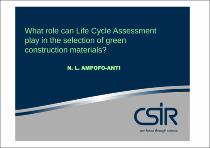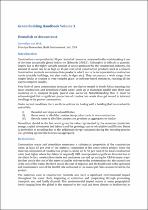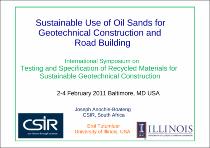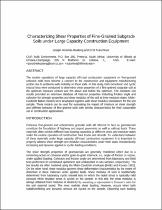 ResearchSpace
ResearchSpace
What role can Life Cycle Assessment play in the selection of green construction materials?
JavaScript is disabled for your browser. Some features of this site may not work without it.
- ResearchSpace
- →
- Research Publications/Outputs
- →
- Conference Publications
- →
- View Item
| dc.contributor.author |
Ampofo-Anti, NL

|
|
| dc.date.accessioned | 2010-03-25T14:06:30Z | |
| dc.date.available | 2010-03-25T14:06:30Z | |
| dc.date.issued | 2009-07 | |
| dc.identifier.citation | Ampofo-Anti, NL 2009. What role can Life Cycle Assessment play in the selection of green construction materials?. Green Building Conference & Exhibition, Sandton Convention Centre, Johannesburg, South Africa, July 2009, pp 1-29 | en |
| dc.identifier.uri | http://hdl.handle.net/10204/3998 | |
| dc.description | Green Building Conference & Exhibition, Sandton ConventionCentre,Johannesburg, South Africa, July 2009 | en |
| dc.description.abstract | The green building movement aims to foster the environmental sustainability of construction products by maximising resource efficiency while minimising concomitant pollution throughout the building life cycle. However, green building principles are rooted in prescriptive methodologies, particularly in the area of construction materials selection and use. The current approaches allow one materials-related environmental problem to be resolved, while generating or ignoring other, potentially more harmful environmental problems which may occur in other parts of the building life cycle. The missing link in basing green construction materials choices on the actual rather than the perceived environmental benefits from specific actions is a systems-based, quantitative analysis of the product of concern. The Life Cycle Assessment (LCA) concept is an environmental management tool which meets these requirements. LCA investigates a product system from "cradle" (where raw materials are extracted) to "grave" (where wastes are disposed of). This approach provides a systematic opportunity to anticipate problems and their solutions all along the life cycle. In the last decade, LCA has emerged as the most appropriate method for a holistic assessment of the environmental performance of whole buildings and construction materials and components. The successful integration of LCA into green construction materials selection and use however entails radical shifts in the approach to the manufacturing, design, on-site construction, use and disposal of construction materials. Additional requirements in respect of environmental legislation and decision-support tools are discussed. | en |
| dc.language.iso | en | en |
| dc.subject | Environmental sustainability | en |
| dc.subject | Construction materials | en |
| dc.subject | Life cycle assessment | en |
| dc.subject | Construction life cycle phases | en |
| dc.subject | Construction life cycle environmental impacts | en |
| dc.subject | LCA applications | en |
| dc.subject | Natural economy | en |
| dc.subject | Human economy | en |
| dc.subject | Construction economy | en |
| dc.title | What role can Life Cycle Assessment play in the selection of green construction materials? | en |
| dc.type | Conference Presentation | en |
| dc.identifier.apacitation | Ampofo-Anti, N. (2009). What role can Life Cycle Assessment play in the selection of green construction materials?. http://hdl.handle.net/10204/3998 | en_ZA |
| dc.identifier.chicagocitation | Ampofo-Anti, NL. "What role can Life Cycle Assessment play in the selection of green construction materials?." (2009): http://hdl.handle.net/10204/3998 | en_ZA |
| dc.identifier.vancouvercitation | Ampofo-Anti N, What role can Life Cycle Assessment play in the selection of green construction materials?; 2009. http://hdl.handle.net/10204/3998 . | en_ZA |
| dc.identifier.ris | TY - Conference Presentation AU - Ampofo-Anti, NL AB - The green building movement aims to foster the environmental sustainability of construction products by maximising resource efficiency while minimising concomitant pollution throughout the building life cycle. However, green building principles are rooted in prescriptive methodologies, particularly in the area of construction materials selection and use. The current approaches allow one materials-related environmental problem to be resolved, while generating or ignoring other, potentially more harmful environmental problems which may occur in other parts of the building life cycle. The missing link in basing green construction materials choices on the actual rather than the perceived environmental benefits from specific actions is a systems-based, quantitative analysis of the product of concern. The Life Cycle Assessment (LCA) concept is an environmental management tool which meets these requirements. LCA investigates a product system from "cradle" (where raw materials are extracted) to "grave" (where wastes are disposed of). This approach provides a systematic opportunity to anticipate problems and their solutions all along the life cycle. In the last decade, LCA has emerged as the most appropriate method for a holistic assessment of the environmental performance of whole buildings and construction materials and components. The successful integration of LCA into green construction materials selection and use however entails radical shifts in the approach to the manufacturing, design, on-site construction, use and disposal of construction materials. Additional requirements in respect of environmental legislation and decision-support tools are discussed. DA - 2009-07 DB - ResearchSpace DP - CSIR KW - Environmental sustainability KW - Construction materials KW - Life cycle assessment KW - Construction life cycle phases KW - Construction life cycle environmental impacts KW - LCA applications KW - Natural economy KW - Human economy KW - Construction economy LK - https://researchspace.csir.co.za PY - 2009 T1 - What role can Life Cycle Assessment play in the selection of green construction materials? TI - What role can Life Cycle Assessment play in the selection of green construction materials? UR - http://hdl.handle.net/10204/3998 ER - | en_ZA |








